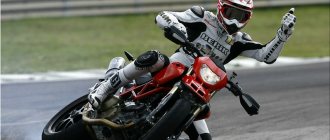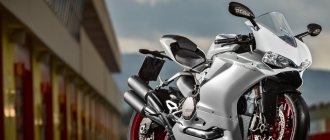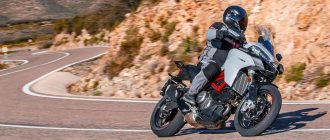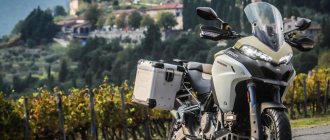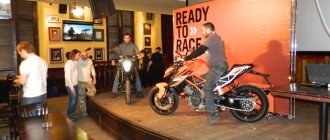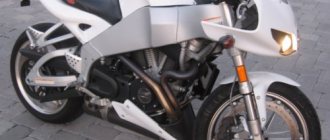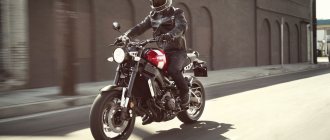Riders looking for a heavy, all-round touring motorcycle should consider the Ducati Multistrada 1200.
Already one of the most powerful motorcycles in the Italian company's line-up, the updated Multistrada is an improved version of the Superbike, equipped with a 1198 cc twin-cylinder engine and various electronic solutions that provide a first-class riding experience.
Ride the Ducati Multistrada 1200 S
The 2015 Ducati Multistrada 1200 S shares less of the Ducati Red body style, with most of the components being completely new designs (with the exception of the keyless ignition system). Ducati continues to develop the dynamic performance of its proven 1098/1198 cc twin-cylinder engine by equipping it with the DVT system, which consists of a variable valve timing mechanism installed in each cylinder head. This system allows engineers to fine-tune the engine by adjusting the camshaft position in real time based on load and rpm. Such a device perfectly complements the existing engine displacement to vary fuel injection and ignition timing, resulting in improved performance, driving characteristics and fuel combustion.
The use of DVT has become a sensation. The system builds on the previous Testatretta design with 11-stage valve overlap, but promotes better overlap, thereby improving engine smoothness at any speed. Where the previous generation of air-cooled Multi engine sputtered and suffered from incredibly poor fuel consumption (especially in the low rev range), the new engine performs smoothly. It revs from 2,000rpm to a top 10,200rpm with ease. It's easily the smoothest-running Ducati we've ever ridden. Another plus of the Ducati Multistrada 1200 S is the improved six-speed transmission. Each gear engages faster, thanks to improvements from the Ducati development team. In addition to the new valve drive technology, valve clearance adjustment intervals have been increased by 5,600 km to 28,800 km.
Despite the milder nature, the engine has not lost its sporting essence. Twist the throttle and the revs pick up so quickly you'll think there's a Panigale underneath you. The performance of the two-cylinder engine is particularly good in the mid-range, with torque maintained at a high level right up to the maximum rev range. The rapid beats of the motorcycle's heart, escaping from the exhaust pipe, echo and awaken the joyful feeling of the thrill of speed.
Engine power and throttle response are adjusted by selecting one of four modes.
Sport and Touring modes offer maximum performance , Sport modes are more aggressive, and Touring modes provide smoother throttle response.
City and Enduro modes are ideal for riding on wet and slippery surfaces , or when a more relaxed ride is required. Each mode has corresponding settings for clutch, front wheel lift, ABS, and on the S model there are also different suspension settings.
If we talk about electronics
Speaking of electronics, the Ducati Multistrada 1200 S is equipped with 1299 Panigale equipment, including an IMU (Inertia Measurement Unit) and a 9.1 M1 anti-lock braking system from Bosch, which takes into account the angle of the motorcycle. The IMU combines the functions of a gyroscope and an accelerometer and corrects the motorcycle's position on the road, taking into account tilt, movement and yaw. This data includes DWC and DCL systems. The DWC system reduces front wheel lift during fast acceleration (reducing torque) and is eight-step adjustable (one being the smallest impact, 8 being the largest). On the road, the front wheel lift control system seems a little too fancy, but it's nice that Ducati engineers are bringing racing technology to the street bikes. The DCL system is a cornering lighting technology. The IMU unit works perfectly in tandem with the Skyhook suspension, as well as ABS. Cruise control is now standard, and heated grips are an optional extra.
MY MOTORCYCLE
The last two generations of the Multistrada seemed to be good for everyone as long-distance companions: slim, fast, nimble, and moderately comfortable. There is only one thing: for all the all-terrain capability declared by the people from Ducati, their habitat, for the most part, has always been limited to paved roads. And some daredevils who decided to go on a round-the-world foray were just the exception that further confirmed the rule: it turned out to be too gentle for such trips, too asphalt... In general, the expedition version was necessary for Ducati like air! Moreover, almost all competitors (primarily BMW and KTM) already have it. And how long.
“Work on the Enduro version began simultaneously with the “standard” version three years ago. And it’s easier for me to say what remains of the original source: the frame and the engine,” like many of his colleagues, engineer Davide Previtera got into the project team, having passed through the racing division of Ducati Corse.
True, almost immediately he makes a clarification: for the sake of better compliance with the off-road ideology of the 160-horsepower L-shaped “twin” Testastretta with the proprietary DVT variable valve timing system, the first gear was “shortened” from 37:15 to 38:14, and the final drive star drive added three teeth. In addition, to prevent the engine from inadvertently flooding when overcoming water obstacles up to 478 mm deep, the muffler was narrowed and raised higher.
They did not touch the Testastretta L-shaped “two” with a variable valve timing system DVT (Desmodromic Variable Timing), two spark plugs per cylinder and a volume of 1198 cm³, soberly assessing that 160 hp. and 136 Nm is more than enough. Although they changed some things. For example, the control unit received more efficient firmware (any owner of the current generation Multistrada can optionally “upload” it at the next maintenance), in order to achieve smooth movement at low speeds, first gear was “shortened” from 37:15 to 38: 14, and for the sake of responsiveness in all ranges, three teeth were added to the driven star. In addition, so that when overcoming water obstacles up to 478 mm deep (+77 mm compared to normal) the engine does not inadvertently flood, the muffler was narrowed and raised higher.
However, this is nothing compared to what had to be done with everything else. Because the transformation of the Multistrada into a rogue forced the designers to reconsider 266 parts!
The fact that the fragile “casting” gave way to heavy, but stronger, spoked wheels, and they themselves adopted the dimensions generally accepted in the crossover environment (3x19 and 4.5x17 inches), need not be mentioned. As well as the fact that the travel of the adaptive suspension Ducati Skyhook Suspension (supplied by Sachs), after modernization which received the Evo prefix, increased to 200 mm (+30 mm) corresponding to the purpose, due to which the ground clearance increased to 205 mm (+31 mm) .
Instead of the fragile 17-inch “casting”, more suitable spoked wheels produced by the famous velogigan Giant in dimensions 3x19 and 4.5x17 inches are installed. By default, they are equipped with the universal Pirelli Scorpion Trail II, but they can also order the off-road Pirelli Scorpion Rally.
It is much more important that as a result of adapting the chassis for off-road use and for greater stability, the fork angle was “blunted” to 25º (+1º), and the base was extended to 1594 mm (+65 mm). Moreover, almost the entire increase in inter-wheel space came from the new double-sided pendulum, which replaced the beautiful, but impractical console one.
The previous single-arm pendulum has been replaced with a more appropriate double-sided one, which is not only stronger, but also torsionally stiffer. The downside was that the wheelbase had grown to 1594 mm (+65 mm), as well as the need to create a new rear wheel hub and relocate the brake caliper.
The feeling behind the wide and 50 mm raised steering wheel of the crossover from Borgo Panigale is unusual. Mainly because the Ducati is finally suitable and comfortable to ride in a standing position! The saddle looks the same, but is fixed at a height of 870 mm from the ground and narrowed, which is why from the outside you no longer look like a person riding on a barrel. The toothless and brittle aluminum brake and gear levers on the Enduro are replaced with steel ones. The brake pedal can be adjusted to a standing or sitting position, and a removable rubber insert eliminates the need to spend money on special off-road pegs.
The narrowed profile of the saddle and the handlebars raised by 50 mm helped adapt the Multistrada’s workplace to off-road conditions. For the same purpose, the toothless and fragile aluminum brake and gear levers on the Enduro are replaced with steel ones. Moreover, the brake pedal can be adjusted to a stand-up or sitting position, and a removable rubber liner eliminates the need to spend money on special off-road “pegs.” True, the saddle height is fixed - 870 mm, and you can change it to 850 or 890 mm only by looking at the factory options catalog.
What is this all for? Understanding does not come immediately, after about half an hour along a mountain path full of cobblestones of various sizes and through three hundred fan slides.
Hugging a 30-liter fuel tank with your knees, bringing a 254-kilogram crossover onto the shifting ground, albeit shod with Pirelli Scorpion Rally, is a special feeling. “Multistrad-Enduro” added 19 kg, but even with a full tank I don’t feel any excess heaviness in the reactions. Standing still or shuffling around the parking lot - yes: the center of mass that has shifted upward makes itself felt. But not on the go! Especially when, together with all the scumbags of the journalistic world, you are trying to “blame all the money.” Any change of direction, despite the impressive weight, proceeds exactly as it should: quickly, predictably and accurately. And the “sticky” long-travel suspension, the adaptive algorithm of which is subject to modes, seems almost invulnerable on a route with stones and half-wheel holes - Ducati swallows them without a hint of breakdowns.
Of course, reactions to the accelerator, switched to the “table-horse” Enduro mode, are damped, but just enough so as not to irritate with sudden bursts of traction from accidental hand movements on gullies. At the same time, without sacrificing responsiveness, allowing you to accurately dose the amount of traction supplied to the rear wheel. There is no urgent need to “twist” the engine to the maximum 10,500 rpm, but the “Italian” is not at all averse to mischief! You lean forward, load the footrest corresponding to the turn, “open” more - and the safety electronics “stretch” the motorcycle in a spectacular skid. Plus, in an “endurance” operating scenario, Bosch’s ABS allows the rear wheel to lock. And if the gut is not thin, you can get rid of the traction with anti-block and anti-wheel. And, believe me, in some cases (for example, on a steep climb with huge boulders), completely manual control will be even preferable!
The frame is the little that remains untouched. The front wheel axle in the 48 mm Sachs fork is shifted 16 mm forward compared to the conventional Multistrada. The tilt angle has been “blunted” to 25° (+1°), and the offset has increased to 110 mm (+4 mm). But the travel of semi-active suspensions, called by the Italians after the modernization of Ducati Skyhook Suspension Evo, increased to 200 mm (+30 mm), and ground clearance - to 205 mm (+31 mm). The algorithm has been rewritten in accordance with the increased mass and changed weight distribution. The front wheel motion sensor is still bolted to the fender, but now it is hidden in a covered niche, which at least somehow guarantees its integrity off-road.
Bliss? One could say so. However, like many other similar mastodons (the same BMW R1200GS Adventure and KTM 1290 Super Adventure), the all-climbing Ducati does not tolerate timidity and understatement in teams. Since you’ve decided to storm the washed-out slope, push your line to the end.
The color instrument panel with a diagonal of 5 inches and four design options (Track, Full, Core and Off Road) is identical to that installed on the road version of the Multistrada. There were no problems with readability even in bright sunshine, and menu navigation is intuitive. In addition, the Bluetooth protocol is supported, which allows you to connect a smartphone to the panel, and then it will display information about incoming or missed calls and received messages, navigator tips, as well as the name of the music track. And if you install the Multistrada Link App on your phone (for now only for iOS), it will turn into a mini data logger.
However, this is off-road, but for asphalt, the “enduro-mult” has a full-power Sport in its temperament selection system, which puts both the power unit, the electronically controlled “adaptive” Skyhook, and the safety electronics into a “particularly excited” state. The suspension undoubtedly becomes stiffer, but the balance is good - there is no tooth-breaking shaking. And in fast turns, excitement appears, supported by instant responses, minimal delays to the impulse of the steering wheel, dense gait and absolute indifference to the quality of the surface.
Although on the deserted serpentines of the southern coast of Sardinia, with their narrow surface and sharp turns, sometimes I wanted to slightly dull the living nerve in the throttle, so as not to be too “careful” with the fuel supply.
Undoubtedly, in the list of “multi-road” moods there is a Touring mode, where 160 “horses” are combined with a relaxed recoil character. But it’s only in demand while you’re sawing along the arrow-shaped highway. And on twisty mountain roads, touring suspensions are depressingly “loose”: they dive excessively at the slightest touch of the brakes, rock the motorcycle at an angle, and drag it out of a bend.
It’s good that you can stop and, plunging into the depths of the menu, go through the settings of each subsystem separately, mixing the ideal combination. But you can’t adjust the suspension hydraulics with a separate button “on the fly,” as competitors do. Why is that?
The technical director of the Italian brand, Andrea Forni, tried to explain: “Creating a motorcycle is such a thing... Everything about everything - from the first drawing to the finished product - usually takes three to four years. But the process of improving it can be continued endlessly - there is always something to improve. Therefore, you need to be able to say “stop!” at a certain moment. And, if we still missed something, try to implement it in the next generation.”
The turn signals placed on the hand protection look impressive. However, the plastic from which they are made is too fragile. As soon as one of my colleagues, while trying to place it on the side stand, slipped and carefully placed the motorcycle on its side, the shield cracked.
The delicate motor underbelly is covered with an impressive aluminum plate. Moreover, for the sake of maintainability, it is attached not to the crankcase, but to the frame through adapters, also made of winged metal.
All key options, many of which bear the Touratech brand, are grouped into four basic packages: Touring (40 and 45 liter aluminum side cases, handlebar bag and heated grips), Enduro (protection bars, oil and main radiator grilles, foglights, chain catcher and rear brake disc cover), Sport (titanium Termignoni muffler, milled expansion tank caps and water pump cover) and Urban (central 38-liter case, tank bag and USB socket extension). Naturally, they can be ordered either as separate sets or en masse.
This time it was not possible to evaluate the effectiveness of LED headlights. However, Italian engineers promise that it should be quite good, and besides, the side sections illuminate the road when turning.
As befits modern technology, Ducati is equipped with a full range of electronic assistants: four modes (Sport, Touring, Urban and Enduro), eight-level DTC traction control, DWC wheelie control, Bosch MP9.1 anti-lock braking system operating in turns and electronic start assistant in hill, holding the brakes on a 46 percent incline.
Bottom line
The Ducati Multistrada 1200 Enduro is a fast, balanced and enjoyable ride for a traveler for whom road quality is no longer a critical factor.
The test is organized. Airoh and Falco equipment was provided by , Five gloves were provided by Mr. Moto.
Issue: MOTO Magazine - July 2016
Author: Roman ABALAKIN, photo by Milagro and the author
Regarding the braking system of the Ducati Multistrada 1200
As for the braking system, both Ducati Multistrada 1200 models use Brembo monoblock calipers. However, the S model gets 10mm larger cross-drilled brake discs to better suit the M50 racing calipers.
The stopping power of both systems has been enhanced with a sports radial master cylinder at the front and a 20mm larger disc at the rear. The braking systems work in full accordance with the manufacturer's claims, and the ABS system is so effective that there is no point in turning it off.
Ducati Multistrada suspension settings
The suspension benefit is the inverted fork, which further reduces the coefficient of friction, and the stroke length is 170 mm. The Multistrada 1200 S model is equipped with a special sensor that records the movement of the suspension. The ECU records this data, as well as data from the IMU, to modify the damping force based on riding conditions. Suspension settings can be adjusted to five settings (softest, softest, medium, hardest, hardest), as on the 1299 Panigale S. The driver can also choose from a variety of shock absorber preload settings (single ride, ride with passenger and/or passenger, on-screen corresponding colored icons appear). The servo drive comes into operation and regulates the tension of the springs. The Ducati Multistrada 1200 is equipped with an easily accessible non-hydraulic adjustment knob. Fork load settings are adjusted in the traditional way: using a wrench.
Display Ducati Multistrada 1200
Display of the Multistrada 1200
The Ducati Multistrada 1200 S is equipped with a large color display that conveys all the operating conditions, while the standard model has a simpler LCD screen. It’s a pity that the screen is not touch-sensitive; its controls are located on the steering wheel. At first the menu seems complicated, but once you understand the principle, everything becomes elementary. Of course, on such an expensive car I would like to see a higher-quality display, rather than mosaic letters and icons. Other nice touches include a 12-volt outlet located next to the display and a USB port under the rear seat.
Multistrada received a new frame and rear suspension swingarm
The standard Ducati Multistrada model receives a new frame and rear suspension swingarm. As a result, not only is the engine positioned higher (the ground clearance is 178 mm), but the steering column angle has also been reduced from 25 degrees to 24. The steering column lock is now also positioned higher by 4 degrees, which improves maneuverability when parking in tight spaces. The wheelbase has not changed and remains 1529 mm.
Unfortunately, we were not able to test all suspension settings, only maximum and standard. But what we saw made us very happy.
Perhaps the most noticeable improvements are in the ergonomics of the Multistrada. The front end has become wider, making the airspace behind the windshield quieter. The seat is available in two versions: height 825 mm and 846 mm. And shorter drivers have the option of lowering the seat height to 840 mm or 800 mm.
The seat width has been reduced by 41 mm. The shape of the fuel tank and seat were changed so that the pilot's knees were more comfortable. The windshield may seem narrow, but it provides excellent protection against turbulent air flow, and is also easy to attach and adjust in height.
After our test drive, we are very pleased with how Ducati has upgraded the 2015 Multistrada. The touring bike retains the authentic sporting characteristics and the DVT engine adds a touch of polish that Ducatis have usually lacked. The bike still corners like it's a sport bike, but it's quieter, smoother, and easier to tune.
Advantages of the Ducati Multistrada 1200 S:
- Engine runs smoother
- Driving fast is a lot of fun
- Improved ergonomics
Disadvantages of the Ducati Multistrada 1200 S:
- S models display could be better
- Front wheel lift control system needs improvement
- Keyless ignition can be a hassle
The Ducati Multistrada 1200 represents a triumph of Italian engineering. This bike is Ducati's top touring model, and it's hard to say what exactly it's good at, because it's good at everything. In addition, the abundance of trim levels, differing in body kit, suspension and various small details, allows buyers to choose a motorcycle “for themselves.” And “Multistrad 1200” is clearly worth taking a closer look at.
All versions of the Ducati Multistrada 1200 share the same frame and engine. The frame is light alloy, which made it possible to keep the dry weight of the motorcycle at approximately 200 kg, plus or minus depending on the configuration. The engine is an L-shaped eight-valve liquid-cooled twin, capable of giving its rider 150 horsepower at peak power. The maximum torque is 125 newton meters. The main advantage of the Multistrada 1200 engine is its wide range of settings. As soon as you press a button, the character of the engine changes as if by magic. So, in city driving mode, the power will be artificially limited to hundreds of horsepower. A similar restriction will come into effect if the Multistrada 1200 engine is switched to “enduro” mode. But in the “sport” and “tourism” modes, the engine will produce everything it is capable of, but in the sports mode the response to turning the throttle will be very sharp, and in the tourist mode, on the contrary, it will be as smooth as possible.
In general, the Ducati Multistrada 1200 is packed with electronics, but thanks to this, the motorcycle is very variable and can be adjusted to your needs. The same ABS system also works differently in different engine modes.
As written above, Multistrada 1200 is available in four versions. The first is the basic version of the same name, and it is, in fact, just a motorcycle, without a body kit. The Touring version is positioned as more suitable for traveling on a motorcycle , and is equipped with hard, waterproof side cases with a volume of forty-eight liters, lockable with a key. The Granturismo version includes side cases increased to seventy-three liters, plus a central case, fog lights and other tires. And the Pikes Peak version is lightweight. Thus, the muffler on this version of the Multistrada 1200 is made of carbon, which reduces weight.
Regardless of the configuration, the Ducati Multistrada 1200 handles well, but despite its enduro claims, we should not forget that this is still a road tourer with the ability to ride on dirt. But it’s probably not worth getting into the mud on this motorcycle - it’s not its element. The Ducati Multistrada is, so to speak, an analogue of a crossover from the world of cars. A very comfortable, stylish and powerful crossover. A twenty-liter gas tank allows you to cover long distances without refueling, especially since gasoline consumption on a motorcycle is quite moderate, especially in touring mode.
The Italians didn't miss a beat with the brakes either. Three brake discs, working in conjunction with modern brake machines, help make braking efficient and predictable, stopping the 200 kg Multistrada 1200 quite quickly. The brakes seem to be sufficient for any riding style. And the customizable suspension allows you to adjust its character to your needs, from the city to the dirt road.
We can say that the Italians from Ducati once again, as in the case of the Ducati Panigale 1299 S , managed to improve an already excellent motorcycle in all respects by rolling out the updated “Multistrad”. A motorcycle balanced in all respects copes well with the tasks that are set before it. Dealers set a considerable price for the Multistrada 1200, but there is an opinion that this motorcycle is worth every penny spent on it.
Similar articles:
- Ducati Panigale 1299 S review
- Kawasaki ZZR 1200 Review
- Yamaha XJR 1200 Review
- Ducati Scrambler Review
- Kawasaki ZRX 1200 Review
- Review of Suzuki GSF 1200 Bandit
LiveJournal
Technical characteristics of the Ducati Multistrada 1200 S:
- Engine: L-shaped with two cylinders, liquid cooling, volume 1198 cm3
- Bore and stroke: 106.0 mm 67.9 mm
- Compression ratio: 12.5:1
- Gas distribution mechanism: DVT, 8 valves
- Fuel Delivery: Single Stage Fuel Injection
- Clutch: Multi-plate in oil bath with hydraulic drive
- Transmission: six-speed
- Main drive: chain, front sprocket 15, rear sprocket 40
- Frame: Trellis steel frame
- Front suspension: 48 mm inverted fork, 3 levels of compression and spring preload: 170 mm travel
- Rear suspension: Sachs gas shock absorber, three levels of compression and spring preload; stroke—170 mm
- Front brakes: 320 mm discs with Brembo radial monoblock calipers
- Rear Brake: 265mm disc with single piston caliper
- Tires: Pirelli Scorpion Trail II120/70R17; Pirelli Scorpion Trail II190/55R17; curb weight—231.8 kg
- Wheelbase: 1529 mm
- Seat height: 825.5 mm
- Fuel tank capacity: 20 liters
- Colors: red, white
- Warranty: two years
TEST DRIVE: Ducati Multistrada 1200S (2010) – Ubiquitous
Surrounded by razor-sharp volcanic formations of the most bizarre shapes, accompanied by the powerful exhaust of the 1200 cc Desmo, I felt completely at peace during this test. The old ST3 and ST4 "airmen" of the same name are defeated once and for all with the arrival of this Goliath, who not only has a big heart, but also a head on his shoulders.
MOTOGONKI.RU, March 14, 2010 - When Ducati launched the 1098R with Racing DTC (racing traction control) unit in 2008, no one suspected how this device would be used on public roads. Then, one after another, the 1198S and Streetfighter came out equipped with this valuable option. The circle came full circle in 2010 with the introduction of the Multistrada 1200S, which embodied the dreams of the ideal sports tourer. The combination of 8-level DTC, a super-powerful 1198cc L-twin and 3-level Ride-by-Wire, coupled with remotely adjustable Ducati Electronic Suspension (DES), is Ducati's chance to fire all the guns, and to get into the “TOP” of both categories of the motorcycle market – sports-oriented and touring models.
Getting to know the motorcycle when you sit in the saddle and start looking at the “cockpit”. What's the point? I remember two things. The first is keyless start. This option will not seem new to Harley owners. Although, the procedure for starting the engine is different. The “key” must be within a radius of 2 meters from the motorcycle. Slide the engine lock button down, then up. The gas tank and glove compartments open without a key. Even the steering column lock is electronic! To release the steering wheel, you need to touch the Engine On/Off key again - this time from side to side. Done, you can go.
After fiddling with the different buttons, I preferred the "Touring" mode, which gave me access to all 150 hp, but significantly flattened the torque curve compared to the full-power "Sport".
Behind the wide handlebars, in the saddle located at a height of 850 mm from the ground, I discovered that there was more than enough space even for me (Sagen’s height is 186 cm - approx. MOTOGONKI.RU). The soft clutch is not at all “Ducata-style” and the 6-speed gearbox is equally atypically soft. First gear engages like clockwork, without much effort. Already on the move, with one button (!) I adjusted the height of the windshield to my height and felt like I was in a real motorcycle paradise. The lower position of the glass also worked great for my helmet, especially at high speeds. The 3-stage heated grips are protected by wide reflectors that shield the pilot's hands from the morning breeze. During numerous trips around the island, we were often accompanied not by a headwind, but by a side wind... But I did not feel the slightest problem with turbulence or course correction.
The touring version of the Multistrada 1200S immediately earned my trust. I think that anyone who buys a “simple” version will immediately equip it with a couple of branded things from the arsenal of “sophisticated” models - this is simply necessary!
What impressed me much more was the instantaneous response of the engine and the powerful pick-up already at 3000 rpm. At 5000 the bike shoots forward like a Eurostar locomotive. A little later in the mountains, my finger automatically ended up on the mode selection button - “SPORT”! Three seconds of holding the key with the throttle closed, and my “cartoon” is already biting into turns in an aggressive manner, but without the slightest sacrifice of comfort. The concept of SPORT-TOURIST smoothly falls into place: here’s SPORT, here’s TOURIST. As you know, Testastretta 1198 is Ducati's top engine, used in World Superbike with minimal changes in design. The derated version differs only in ignition settings and smooth operation: in the touring version, ignition is carried out at 11 degrees, in the sports version - at 41. Here, smooth, clear acceleration at the “lower” levels is much more important, but this car will also allow you to show off a pair of beautiful wheels at any time.
After all, the ratio is 150 hp. at 189 kg of dry weight it looks very decent. Well-designed exhaust end caps are Euro 3 certified, so those with very skillful hands have a reason to start tuning (Termignoni, as usual, offers a lot of options... even before the motorcycle itself goes on sale). Ducati engineers explained in a nutshell that even at an 11-degree “tourist” fuse, this will allow you to pull a couple of fillies out of the 1200 cc engine. Testastretta greedily sucks in air through two forward-protruding portals and delivers the flow directly to the injector. Externally, this “beak” reminds us of Adventure style motifs. The latest version of the engine allows you to reduce the number of service visits to once every 24,000 km, which Ducati is very proud of.
There's nothing superfluous about the Multistrada 1200S. Traction control and three different ignition maps make it easy to switch between four modes. Having satisfied my curiosity in “Touring” and “Sport” (both give access to full engine power, but with different suspension and DTC settings), in the village I switched to “Urban” mode. I immediately felt how much the pendants sank and became limp. The engine was “blown away” to 100 hp, and the traction control indicator showed “6” (in “Sport” mode it was “4”). This means that electronic intervention in the driver's actions has increased to almost extreme levels in order to enhance passive safety on slippery patches and dust spots. Together with the ABS integrated into this entire system, the Multistrada 1200S seems to me to be one of the safest bikes in the history of motorcycle manufacturing. At least for the city. The bike jumped over longitudinal, transverse, diagonal, dirty, clean - any bumps and holes with the ease of a motard. The only thing missing from the set were seat belts!
I was in vain worried that the “drawdown” was 50 hp. will leave an unpleasant aftertaste from driving a motorcycle. This feature largely relates to excessive play with the throttle, which is of no use to a sober-minded rider on the road; in heavy traffic, he must concentrate on the driving itself. Avoid troubles by predicting them, rather than dodging them at the last moment. [nxtpage]
Last but not least is the narrowly designated "off-road section" of the Multistrada. With Enduro mode selected, I drove many miles trying to understand the difference between city and off-road modes. After all, they both use a 100 hp limit, but completely different settings for the other units. The suspensions were unloaded even more than with “Urban”, but the number “2” was clearly read on the DTC display. On asphalt, the character of the Multistrada changed in the most dramatic way. The most accurate description of the sensations when switching from “Sport” to “Enduro” is as if both tires suddenly went flat! Such a big difference between the two suspension settings. We were left with a small gravel trip around the island of volcanoes for dessert, but no matter how hard I tried to enter the turn with a spectacular drift for photographers, the DTC broke me off every time. And this is at level “2”! Of course, if we had a little more time in the pampas, I would have found a reason to slide beautifully by slightly adjusting the Enduro mode settings. But, alas, there was no time for this at all.
However, Ducati leaves this option open to any owner. The only thing is that engineers recommend doing anything yourself only under the supervision of experienced mechanics. Any ascetic endurologist could soon become a sybarite, spoiled by the high technologies of Ducati, if it is not possible to completely exclude ABS and DTC from the scheme. Remembering my own African adventures on the BMW R1200GS, I note that Ducati missed one small feature - the ability to force ABS to be turned off with a separate button.
Not sure if the Multistrada was even intended for multi-day desert or gravel racing, I approached Fabio Sabbioni with this question. The main reason why the MTS 1200S is mounted on 17-inch wheels (and the rear wheels are very wide - 190 mm) is to ensure maximum safety when driving on asphalt and to realize the potential of the 150-horsepower engine. Specially developed for Ducati, Pirelli Scorpion tires are rated “ZR”, which means they are safe to use at speeds up to 270 km/h. From familiar Pirelli insiders, I learned that with these tires you can easily reach 300 km/h and even higher, even with a fully loaded Multistrada 1200S. But on gravel, this wheel would start to slip at half the power. In my case, even a completely unscrewed trigger did not allow me to overcome the tricky DTC. We came to the conclusion that the “Enduro” mode was created for absolute beginners. But Ducati recommends using all the features of the bike, regardless of experience. Otherwise, what would be the point of buying a Multistrada 1200S?
They didn’t go into much detail about the operation of the “remote control” mechanism over the suspensions. Ohlins has done a lot of work to adapt the fast-tuning technology of its TTX-type suspensions from MotoGP to the civilian tourer. The 48 mm inverted fork and monoshock absorber with servo drives change their characteristics at lightning speed, “twisting” and loosening the spring preload adjustment. The number of “turns” is hardwired into memory. Of course, the biggest impression on me was changing the settings “on the fly” when switching from sport mode to “Enduro” - the motorcycle changed quietly and very quickly, and most importantly, noticeably. The free travel of the suspension remains unchanged – 170 mm. When setting up, you can also specify the riding mode “With a passenger”, which would additionally load the rear of the motorcycle. With or without it, the Multistrada handles fantastically. It was not possible to test the brakes in extreme mode, but what can you expect from the most powerful radial Brembos?
Bottom line:
The Ducati Multistrada 1200S can definitely be any traveler's dream motorcycle. In this incarnation he is beyond competition. There are so many different things and devices that you can experiment with, learn and experience, and then use wisely and wisely every single day! And the main thing in all this computer temptation is not the mileage. Mileage shouldn't matter at all to an MTS 1200S owner. Capacity matters when we're talking about the engine and luggage racks, and the Mutlistrada has both. Look out, BMW GS! Your only advantage now is the eternal cardan.
Pros: + Powerful enough to outlast everyone + Comprehensive and adaptive + Light weight improves handling + Comfortable and probably very reliable + Official service interval of 24,000 km!
Cons: - Not sufficiently tested by time and off-road tests - The most expensive 1200 cc tourer in existence
Tor Sagen from the island of Lancerote, Spain Special for MOTOGONKI.RU Photos: Milagro



